Florida Motorcycle Handbook: S.E.E.
5. Ride within your Abilities
- 5.1. Basic Vehicle Control
- 5.6. Keeping your Distance
- 5.7. Lane Positions
- 5.8. Following Another Vehicle
- 5.9. Being Followed
- 5.10. Passing and Being Passed
- 5.11. Lane Sharing
- 5.12. Merging Cars
- 5.13. Cars Alongside
- 5.14. S.E.E.
- 5.15. Increasing Rider Visibility
- 5.16. Crash Avoidance
- 5.17. Handling Dangerous Surfaces
- 5.18. Mechanical Problems
- 5.19. Unavoidable Hazards
- 5.20. Getting Off the Road
- 5.21. Carrying Passengers and Cargo
- 5.22. Group Riding
- 5.23. Riding While Impaired
Good experienced riders remain aware of what is going on around them. They improve their riding strategy by using SEE, a three-step process used to make appropriate judgments, and apply them correctly in different traffic situations:
- Search
- Evaluate
- Execute
Let's examine each of these steps.
5.14.1 - SEARCH
Search aggressively ahead, to the sides and behind to avoid potential hazards even before they arise. How assertively you search, and how much time and space you have, can eliminate or reduce harm. Focus even more on finding potential escape routes in or around intersections, shopping areas, school and construction zones.
Search for factors such as:
- Oncoming traffic that may turn left in front of you.
- Traffic coming from the left and right.
- Traffic approaching from behind.
- Hazardous road conditions.
Be especially alert in areas with limited visibility. Visually "busy" surroundings could hide you and your motorcycle from others.
5.14.2 - EVALUATE
Think about how hazards can interact to create risk for you. Anticipate potential problems and have a plan to reduce risk.
- Road and surface characteristics - Potholes, guardrails, bridges, telephone poles and trees won't move into your path but may influence your riding strategy.
- Traffic control devices - Look for traffic signals, including regulatory signs, warning signs, and pavement markings, to help you evaluate circumstances ahead.
- Vehicles and other traffic - May move into your path and increase the likelihood of a crash.
Think about your time and space requirements in order to maintain a margin of safety. You must leave yourself time to react if an emergency arises.
5.14.3 - EXECUTE
Carry out your decision.
To create more space and minimize harm from any hazard:
- Communicate your presence with lights and/or horn.
- Adjust your speed by accelerating, stopping or slowing.
- Adjust your position and/or direction.
Apply the old adage "one step at a time" to handle two or more hazards. Adjust speed to permit two hazards to separate. Then deal with them one at a time as single hazards. Decision making becomes more complex with three or more hazards. Weigh the consequences of each and give equal distance to the hazards.
In potential high-risk areas, such as intersections, shopping areas and school and construction zones, cover the clutch and both brakes to reduce the time you need to react.
INTERSECTIONS
The greatest potential for conflict between you and other traffic is at intersections. An intersection can be in the middle of an urban area or at a driveway on a residential street - anywhere traffic may cross your path of travel. Over one-half of motorcycle/car crashes are caused by drivers entering a rider's right-of-way. Cars that turn left in front of you, including cars turning left from the lane to your right, and cars on side streets that pull into your lane, are the biggest dangers. Your use of SEE [p. 13] at intersections is critical.
There are no guarantees that others see you. Never count on "eye contact" as a sign that a driver will yield. Too often, a driver looks right at a motorcyclist and still fails to "see" him. The only eyes that you can count on are your own. If a car can enter your path, assume that it will. Good riders are always "looking for trouble" - not to get into it, but to stay out of it.
Increase your chances of being seen at intersections. Ride with your headlight on in a lane position that provides the best view of oncoming traffic. Provide a space cushion around the motorcycle that permits you to take evasive action. As you approach the intersection, select a lane position to increase your visibility to the driver. Cover the clutch and both brakes to reduce reaction time.
Reduce your speed as you approach an intersection. After entering the intersection, move away from vehicles preparing to turn. Do not change speed or position radically. The driver might think that you are preparing to turn.
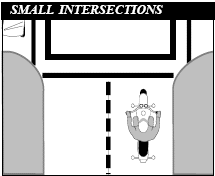 |
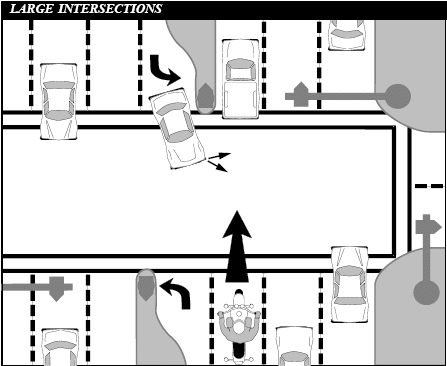 |
BLIND INTERSECTIONS
If you approach a blind intersection, move to the portion of the lane that will bring you into another driver's field of vision at the earliest possible moment. In this picture, the rider has moved to the left portion of the lane - away from the parked car - so the driver on the cross street can see him as soon as possible.
Remember, the key is to see as much as possible and remain visible to others while protecting your space.
If you have a stop sign or stop line, stop there first. Then edge forward and stop again, just short of where the cross-traffic lane meets your lane. From that position, lean your body forward and look around buildings, parked cars, or bushes to see if anything is coming. Just make sure your front wheel stays out of the cross lane of travel while you're looking.
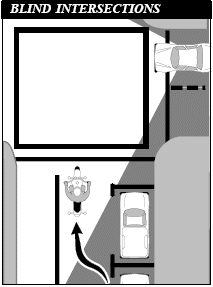
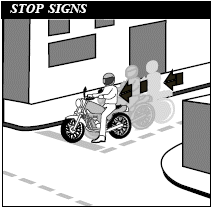
PASSING PARKED CARS
When passing parked cars, stay toward the left of your lane. You can avoid problems caused by doors opening, drivers getting out of cars or people stepping from between cars. If oncoming traffic is present, it is usually best to remain in the center-lane position to maximize your space cushion.
A bigger problem can occur if the driver pulls away from the curb without checking for traffic behind. Even if he does look, he may fail to see you.
In either event, the driver might cut into your path. Slow down or change lanes to make room for someone cutting in.
Cars making a sudden U-turn are the most dangerous. They may cut you off entirely, blocking the whole roadway and leaving you with no place to go. Since you can't tell what a driver will do, slow down and get the driver's attention. Sound your horn and continue with caution.
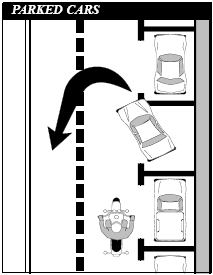 |
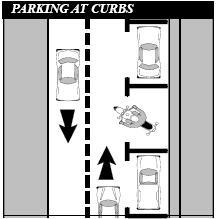 |
PARKING AT THE ROADSIDE
Park at a 90° angle to the curb with your rear wheel touching the curb.
Check out our Customer Reviews!


